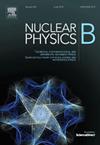A5 symmetry and deviation from golden ratio mixing with charged lepton flavor violation
IF 2.5
3区 物理与天体物理
Q2 PHYSICS, PARTICLES & FIELDS
引用次数: 0
Abstract
A neutrino mass model that can satisfy the exact golden ratio mixing is constructed using discrete symmetry group. The deviation from the golden ratio mixing is studied by considering the contribution from the charged lepton sector in a linear seesaw framework. A definite pattern of charged lepton mass matrix predicted by the model controls the leptonic mixing angles. By taking the observed as the input value, we can obtain the values of all the mixing angles and Dirac CP-violating phase within the current experimental bounds.
The model predicts that only the normal neutrino mass ordering is consistent with the current oscillation data. We also study the two body charged lepton flavor violation (cLFV) processes such as , and and neutrinoless double beta decay parameter . The present neutrino mass model can explain the current and future sensitivity of , processes and the present sensitivity of neutrinoless double beta decay parameter when the masses of quasi-Dirac neutrinos are in the TeV range. On the other hand, the model cannot reproduce the present sensitivity of but can explain the future sensitivity and the present sensitivity of neutrinoless double beta decay parameter simultaneously when the masses of the quasi-Dirac neutrinos are in the TeV range.
求助全文
约1分钟内获得全文
求助全文
来源期刊

Nuclear Physics B
物理-物理:粒子与场物理
CiteScore
5.50
自引率
7.10%
发文量
302
审稿时长
1 months
期刊介绍:
Nuclear Physics B focuses on the domain of high energy physics, quantum field theory, statistical systems, and mathematical physics, and includes four main sections: high energy physics - phenomenology, high energy physics - theory, high energy physics - experiment, and quantum field theory, statistical systems, and mathematical physics. The emphasis is on original research papers (Frontiers Articles or Full Length Articles), but Review Articles are also welcome.
 求助内容:
求助内容: 应助结果提醒方式:
应助结果提醒方式:


